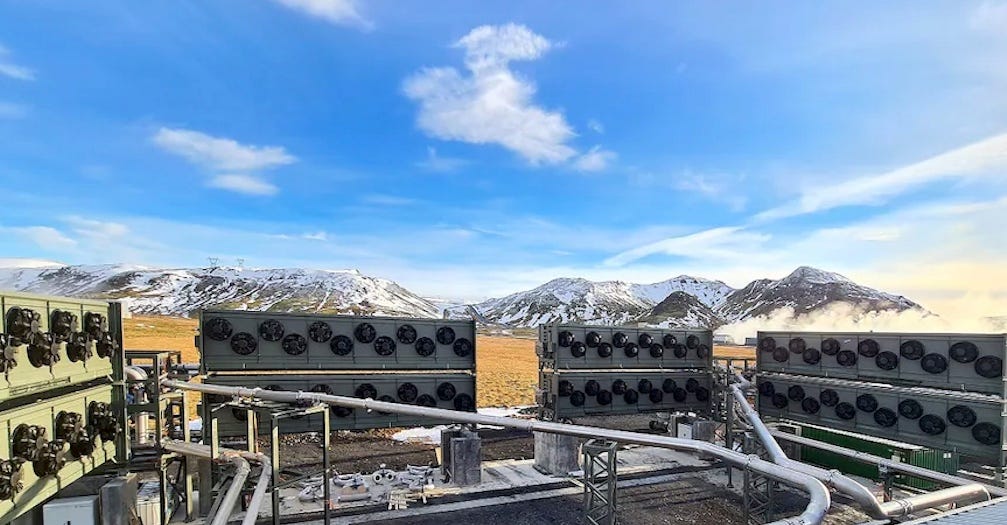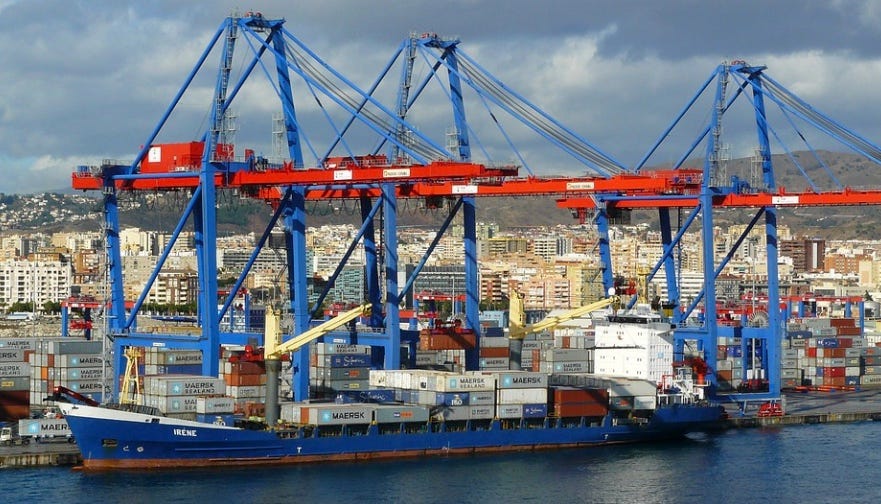Solar investors unimpressed with Biden forecast; plus Tom Steyer's new climate fund
Welcome to Callaway Climate Insights. Only one month until our Countdown to COP26 investor checklist event. Stay tuned for details.
Callaway Climate Insights publishes Tuesdays and Thursdays for everybody. To get our insights and analysis every day, please subscribe.
Swiss company Climeworks, which focuses on CO₂ air capture technology, just launched Orca, the world’s first and largest climate-positive direct air capture and storage plant. The Iceland installation is expected to capture 4,000 metric tons of CO₂ each year serve as a blueprint for new climate technology.
Some presidential messaging works better than others. It is a measure of how despondent some climate solution investors have become this summer that a government report forecasting solar energy will become the dominant form of energy in the U.S. by 2050 failed to nudge solar stocks at all.
Beset by supply chain issues tied to China and inflation concerns, solar investors will need to see more than rosy predictions to get excited, especially as President Biden’s infrastructure bill remains tied up in Congress.
The Invesco Solar ETF (TAN), down more than 17% year to date, failed to bump at all yesterday when the Energy Dept. forecast was announced with great fanfare. Popular solar stocks such as First Solar (FSLR) and NextEnergy Solar (NESF) were also lower, although First Solar popped a bit today on the second-day headlines.
Still, the administration is eager to generate some good news ahead of the COP26 climate summit in Scotland in November, and the solar industry is positioning itself for sharp growth behind the headlines. More than $6.4 billion was invested in solar projects in the U.S. in the second quarter, up from $5.3 billion in the first quarter, according to BloombergNEF. It is by far the most attractive renewable industry in terms of money invested this year.
Some emerging market trends bear watching longer than others. With global oil production now hitting pre-pandemic levels, the case for a quicker transition to renewable energy such as solar and wind becomes more important each day. If evidence of the energy department’s optimism begins to show up, a rebound in solar stocks will be in order.
More insights below. . . .
Don’t miss The Great Repricing, a four-day virtual conference on ESG investing held by Gitterman Asset Management from Sept. 21-24. To get a 10% discount on tickets, use the code DavidC100 when you sign up here.
Don’t forget to contact me directly if you have suggestions or ideas at dcallaway@callawayclimateinsights.com.
ZEUS: The supply chain problem's silver climate lining
. . . . A silver lining in the global supply chain crisis caused by Covid is starting to emerge in the form of corporate pledges to revamp not only their direct carbon emissions but also to push to reduce those of their vendors, writes David Callaway. Cuts in indirect, or Scope 3, emissions are starting to create a domino effect in supply chains as more vendors adapt to client demands. Think Amazon (AMZN) and Microsoft (MSFT) and all their shipping vendors. For investors, Scope 3 will emerge as a key metric in determining who is serious about carbon reduction and who will be next. . . .
EU notebook: Steel costs expected to double as industry moves to hydrogen

. . . . European steel leaders expect prices to double by 2030 as the industry transitions to using hydrogen from fossil fuels in steel production, writes Daniel Byrne from Dublin. One of Europe’s largest industries, valued at about €140 billion ($165 billion) last year, the cost of making steel is closely watched as a sign of economic activity. As Europe bets on transitioning to hydrogen as a fuel source, steel leaders say they expect their costs to rise from 30% to as much as 100% in the near term, and that some form of financial support will be needed. . . .
Thursday’s subscriber insights: Steyer and Musk attack climate from different angles
. . . . Tom Steyer’s Galvanize Climate Solutions, a new fund announced today with partner Katie Hall, which will invest billions in decarbonization projects, one of the hottest areas of climate solutions this year. The fund will invest in companies ranging from startups to massive business expansions, and is being supported by Marc Benioff’s Time Ventures. Read more here. . . .
. . . . Meanwhile, Elon Musk’s nascent Autobidder energy trading business is adding traders, betting that selling energy to utilities will become a big business again as the U.S. transitions its electricity grid. The Tesla (TSLA) titan, who along with his automotive business is expanding the company’s battery operations and home Powerwall units, is getting ahead of what could be a big trend as vulnerable grids search for new forms of renewable electricity to replace fossil fuels. Read more here. . . .
. . . . Toyota, a pioneer in the hybrid automotive game with its Prius a decade ago, has been slow to embrace full electric vehicles. That is about to change with the introduction of a new EV model next year, and an announcement of a $13.5 billion investment in new battery technology this week. Can an energy-trading business be far behind? Read more here. . . .
. . . . America’s electric charging station conundrum — too few stations making little money are causing buyers to hesitate to buy EVs — will not get the jump start it needs from the $7.5 billion investment from the government’s infrastructure plan. Until someone figures out how to make money on these things, Europe and China, which both heavily subsidize them, will continue to lead the way. Read more here. . . .
. . . . Part of the calculation behind the energy department’s forecast that solar energy will become half of all energy used in the U.S. is the idea that solar panel costs will come down dramatically, compared to say, wind turbines. While that may be true over the next 30 years, at present there is little sign of cost reductions. Now, an Australian entrepreneur claims to have found a way to use silver, instead of high-priced copper, in the production of panels. Not surprisingly, he’s attracting a crowd. Read more here. . . .
Editor’s picks: New York wants zero-emission vehicles; EPA seeks stronger methane limits


New York wants zero-emission vehicles by 2035
New York Gov. Kathy Hochul has signed into law a bill that sets a goal for all new passenger cars and light-duty trucks sold in the state to be zero-emission models by 2035. The new regulations require higher numbers of zero-emission vehicles with a goal of “100% of in-state sales by 2035,” and a similar target for medium-duty and heavy-duty vehicles by 2045 if feasible. California also recently committed to stopping the sales of new gasoline-fueled vehicles. A report from Reuters notes the federal government is seeking to promote the sales of electric vehicles to reduce the consumption of fossil fuels and help meet global goals to slow human-caused climate change.
EPA seeks stronger methane limits
The Environmental Protection Agency is set to propose the nation’s strongest rules against methane emissions this month, escalating the Biden administration’s use of regulatory tools to reduce greenhouse gases from fossil fuel companies. E&E News reports that EPA Administrator Michael Regan confirmed his agency will meet President Biden’s September deadline to propose methane regulations for the oil and gas sector, as laid out in one of the president’s first executive orders. The upcoming rules for new and existing oil and gas infrastructure are expected to be stricter even than an Obama-era standard set in 2016, which was reinstated in June after Congress took the unusual step of invalidating a Trump EPA rollback and replacement rule.
Latest findings: New research, studies and projects

Climate-related disasters and death tolls
With climate change accelerating, the frequency of climate disasters is expected to increase in the decades to come. There is ongoing debate as to how different climatic regions will be affected by such an acceleration. In a paper titled Climate-Related Disasters and the Death Toll, Swiss Finance Institute Research Paper No. 21-63, the authors describe a model for predicting the frequency of climate disasters and the severity of the resulting number of deaths. The frequency of disasters is described as a Poisson process driven by aggregate CO₂ emissions. The severity of disasters is described using a generalized Pareto distribution driven by the trend in regional real gross domestic product per capita. The authors predict the death toll for different types of climate disasters based on the projections made by the Intergovernmental Panel on Climate Change for the population, the regional real GDP per capita, and aggregate CO₂ emissions in the “sustainable” and “business-as-usual” baseline scenarios.
More of the latest research:

Words to live by . . . .
“We are determined that we are going to deal with climate change and have net emissions by 2050. We’re going to be able to do these things. But we’ve got to move. And we’ve got to move the rest of the world. It’s not just the United States of America.” — President Joe Biden, speaking in the aftermath of Hurricane Ida.




